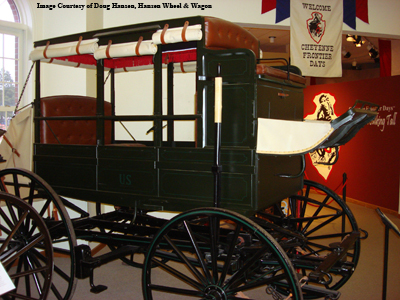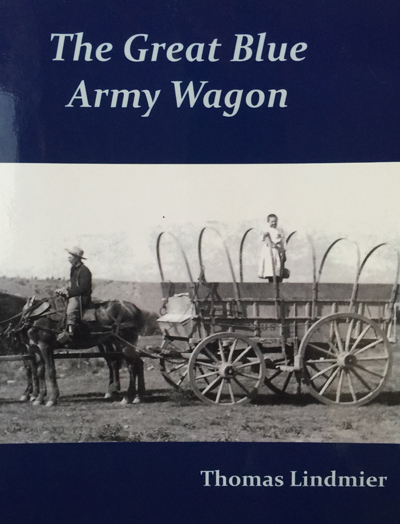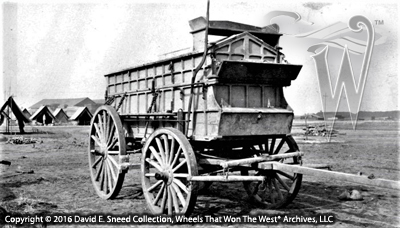Last week, I passed along some details about a uniquely designed touring coach with four brake blocks. It got me to thinking about other western vehicles that we almost never see. Of course, I've talked before about popular brands that are hard to come across. Names like Cooper, Star, Flint, Whitewater, Caldwell, Kansas, Jackson, LaBelle, Rushford, and others are profiled in early trade publications as significant and highly desired brands. Even though I've shared details before on some of these particular companies, I don't think I've ever approached the overall subject as it relates to scarce design styles.
So, this week, I thought I'd focus on a few early American wagon designs that are tough to find. Before we dive in, though, it's important to recognize that almost all of the wheels we talk about from week to week can be classified as "rare." After all, this part of our history has long since passed. So, when we talk about quality horse-drawn vehicles with a build date harkening back at least 90 years or more, we're talking about an elite group of hard-to-find survivors. Museum grade pieces from these eras have outlived harsh use, unforgiving environments, and the aging process in general. Likewise, they've escaped countless recycling and repurposing projects along with a host of parting-out and demolition ventures as later generations focused on "cleaning out the old barn." With so many risks lying in wait for almost every old set of wheels, there are several types of wooden vehicles that stand out as being even more challenging to find.
With that as a backdrop, we'll skip past discussions covering elusive brands or manufacturing dates and briefly focus on a handful of vehicle types. These configurations will be among the most difficult to catch a glimpse of - let alone be lucky enough to acquire. After all, how many original, period examples of the following western vehicle types have you seen in a private collection... Low Wheel Mountain wagon, Dougherty wagon, Dearborn wagon, Six Mule Army wagon, or Engineer's Tool wagon? While photos and/or period illustrations exist for most of these, it's hard to find even a half dozen actual examples for any one of the vehicles. It's apoint that makes individual study and field recognition of old parts even more crucial.
Low wheel Mountain wagon - Perhaps one of the more rarely-seen western designs, I stumbled across this variation purely by accident. A number of years ago, I was doing research on an old Studebaker wagon gear that had been purchased in Colorado. From the bolster stake irons to the reach pattern, tire rivets, 10-inch steel skeins, heavy-duty ironing, and numerous other features, the piece bore all the markings of a Studebaker Mountain Wagon. Yet, the wheels were shorter - not the typical configuration often associated with these heavy-duty work horses. Instead of being at least 52 inches in height, the rear wheels were 46 inches tall and the front measured 38. The overall design stood on a 56-inch track width. As part of my study, I combed through some of our earlier Studebaker materials and quickly came across several promotional illustrations and specifications for... you guessed it - a 'low wheel' Mountain wagon. Turns out that, during the 19th and early 20th centuries, Studebaker built and marketed both a 'high wheel' and 'low wheel' Mountain wagon. The variation I uncovered from Colorado was highlighted feature-for-feature and spec-for-spec in multiple, century-plus-old catalogs. Just as the high wheel Mountain wagons were ruggedly purposed, this 'vertically-challenged' gear was engineered for hard use and heavy loads in mountainous regions. The shorter wheels provided a lower center of gravity and optimum stability over the most demanding and uneven terrain.
 |
| Despite their lengthy service within the military, very few original Dougherty wagons have survived. |
Dougherty wagon - Purportedly originating in St. Louis, Dougherty wagons were used throughout the early days of the American frontier and into the 20th century. There were slight changes in the ultra-nimble design over the years, including a raised driver's seat and cut-under body for tighter turning. Most nineteenth century Dougherty wagons were equipped with a set of elliptical springs balancing all four corners of the body. They featured doors on both sides, canvas curtains that could be raised and lowered, and a luggage rack in the rear. The design was also referred to as an ambulance and was often used to transport officers and their families as well as paymasters and other special needs related to military business. A good example of one built by the Kansas Manufacturing Company is located in the Cheyenne Frontier Days Old West Museum in Cheyenne, Wyoming. An even earlier Dougherty can be seen in the collection at Grant-Kohrs Ranch National Historic Site in Deer Lodge, Montana and still one more is shown at Fort Hartsuff State Historical Park in Nebraska.
In 1911, L. Mervin Maus, a Colonel inthe U.S. Army reminisced about his past experiences with the wagon...
"Anyone who has failed to travel in a Dougherty wagon has never enjoyed one of the real pleasures of life and one of the genuine refinements of wheel transportation. He has missed something which has left a hiatus in his life and a blank that can never be filled until he finds himself at last safely seated in one of these classical army chariots, behind four snappy, faithful, and patriotic government mules, such as for generations have been the friend of the army at frontier posts and his ally in conducting campaigns..."
Dearborn wagon - Easily one of the most elusive sets of early frontier wheels, Dearborn wagons were regularly discussed in early diaries and journals of those headed through the American West. In his book, "CarriageTerminology: An Historical Dictionary," Don Berkebile includes a good - and somewhat lengthy - description of the vehicle along with an illustration froman 1879 issue of "The Carriage Monthly." With its name attributed to General Henry Dearborn, the vehicles were used throughout the 19th century for hauling both freight and passengers. There were multiple variations over time and a variety of names such as Jersey wagon and Carryall were sometimes used to describe a Dearborn.

Tom Lindmier's book, "The Great Blue Army Wagon,"includes a host of details on America's early military vehicles and harness.
Six Mule Army wagon - Most surviving military wagons seem to be of the lighter Escort or four mule designs. Even so, there was a larger and more robust version developed prior to the Civil War. Referred to as the Six Mule Army wagon, these configurations were important for hauling baggage, supplies, rations, and other large loads. The reinforced patterns were popular within military circles due to the tremendous durability and versatility of the design. According to Thomas Lindmier in his book, "The Great Blue Army Wagon," these vehicles were also occasionally used as an ambulance. Advantages over Four Horse/Mule wagons included heavier wheels, larger axles, and the ability (since there were two more mules) to travel greater distances with less pressure on the draft animals. Developed in the mid-1850's, the designs were used by the military into the 1930's. One of the few surviving Six Mule wagons is located in Douglas Wyoming at the Pioneer Memorial Museum. It was built by a maker almost unheard of by collectors and historians today. His name was Louis Palm and his shops were located on South Jefferson street in Chicago. For more details on this type of transport, check out Mr. Lindmier's book. It's a great volume of research that should be in every enthusiast's library.

A military "Tool" wagon was essentially a huge, wooden tool box positioned on an Escort wagon gear.
Engineer's Tool wagon - One of the rarest horse-drawn military wagons, these specialty vehicles were in use as early as America's Civil War and throughout the early 20th century. These vehicles were typically composed of an Escort wagon gear carrying a sizeable wood-framed box. Larger, but similar to a drummer's (salesman's) wagon, the box was enclosed and compartmentalized. Each section inside the box was designed to hold a variety of tools, equipment, and materials needed to build roads, bridges, and other military necessities. Examples of items included could be axes, picks, levels, sledges, shovels, lanterns, hatchets, crow bars, wrenches, carpenter's and saddler's tools, blacksmith materials, paint brushes, wire, and numerous other essentials. In spite of their presence within the military over such a broad timeframe, Tool wagons are about as common today as leprechauns and unicorns. I've searched high and low, managing to come up with a few old photos, illustrations, specifications, and period writings. Even so, I've yet to set my eyes on an actual survivor.
While some of the designs discussed here can be found in a very limited number of museums, as a general rule, they remain among the most difficult to come across anywhere. Should you know of additional examples beyond those mentioned above, I'd enjoy hearing more about those survivors as well. In addition to the wheels above, there are a number of other heavier transports that are next to impossible to locate. Among those are the Davis Iron Wagon gear, first introduced around 1880 and tested for use by the U.S. military. Other obscure pieces include Herdic Coaches and the McMaster Camping Car. Truth is, there are a slew of early vehicle types that are still among the missing. So, if you're partial to a good mystery and enjoy treasure hunts, there are plenty of pieces from America's first transportation industry that are waiting to be found. So, the next time you see an old horse-drawn vehicle that looks a little different, do some investigating. It just might be one of a number of pieces that we thought were lost to time!
Please Note: As with each of our blog writings, all imagery and text is copyrighted with All Rights Reserved. The material may not be broadcast, published, rewritten, or redistributed without prior written permission from David E. Sneed, Wheels That Won The West® Archives, LLC
Please Note: As with each of our blog writings, all imagery and text is copyrighted with All Rights Reserved. The material may not be broadcast, published, rewritten, or redistributed without prior written permission from David E. Sneed, Wheels That Won The West® Archives, LLC